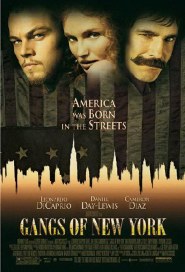cameron diaz movies
|
|
Chapter 5 - Authentic Fighting Methods of the 1860s
 Gangs of New York takes the audience back into a time when conflict raged in America – both on the battlefield and in the streets. It was a time of primitive battles, often fought man-on-man, with home-made weapons and an eerily personal brutality. Scorsese wanted to reveal a world with such savage street brawls, alien weaponry and unusual fighting styles that it appears almost medieval – or perhaps, futuristic. Gangs of New York takes the audience back into a time when conflict raged in America – both on the battlefield and in the streets. It was a time of primitive battles, often fought man-on-man, with home-made weapons and an eerily personal brutality. Scorsese wanted to reveal a world with such savage street brawls, alien weaponry and unusual fighting styles that it appears almost medieval – or perhaps, futuristic.To the 21st century viewer, Leonardo DiCaprio’s fighting style and stances may look odd, but they are true to his times. To learn more about the authentic fighting methods of the 1860s, Scorsese brought in stunt coordinator George Aguilar and fight consultant Dominic Vandenberg, who worked closely with the actors, ensuring that they adopted the formal standing positions from which fighters of the era traded punches.
Aguilar and Vandenberg also uncovered the unusual armory use in street fights. In the 1846 fight between Priest Vallon and Bill the Butcher – the fight that will determine who controls the Five Points – the weapons are everyday objects turned deadly. Aguilar explains, “Their weapons are the garden-variety kind, literally. Shovels, picks, hoes, and axes. And they carry hard wood clubs, and even mace. There are no guns involved in the encounter, so the task was to come up with imaginative ways of fighting with the weapons at hand.”
All the action in GANGS OF NEW YORK leads to the inexorable, monumental final battle between Amsterdam and Bill the Butcher against the intense backdrop of the Draft Riots. These scenes, an apotheosis of all that has come before, merge the personal drama of the two men with the cataclysmic event that has overtaken the entire country – the Civil War.
The sheer numbers of those involved in the scene was a big concern for George Aguilar. He relates, "Instead of a hundred Dead Rabbits versus a hundred Native Americans, we had several hundreds working, and that included gang members and the local populace, as well as the battalions of Union soldiers converging on the city. We approached the shooting of each episode as if we really were in the Army, and divided our hundreds of players into groups of smaller platoons. We placed someone in charge of each group. The platoon leaders would convey Marty's directions to their group."
The number of stunt players and scope of the action meant that action unit director Vic Armstrong also filmed during the riots. "The final battle scene of the film differs greatly from the opening sequence," Armstrong says. "The arrival of the troops to put down the rioters is a veritable artillery barrage. It's a pure action sequence, and there's a lot of color. We have explosions detonating, fires raging, and mobs going wild breaking windows, looting buildings, setting fires, attacking helpless people. My job was to work on filming details--shattering windows, marching feet, anonymous soldiers discharging round after round of fire."
Despite the fighting that engulfs the Five Points during the Draft Riots – shells exploding everywhere and carnage piling up – the battle between Amsterdam and Bill the Butcher comes down in the end to one-on-one combat. "We didn't want anything to look too modern," Aguilar says. "In those days, a fight was stylized, ritualistic. It was vicious, absolutely fierce. Opponents were out to maim each other. You used parts of your own body as a weapon. You had head butting, eye gouging and ear biting. It was rough and tumble, down and dirty – merciless."
DiCaprio and Day-Lewis worked for months with Scorsese and Aguilar to perfect their fighting style. "Physically I began preparing for this role about eleven months before the actual start date," DiCaprio says. "My regimen included weight training, knife throwing and various fighting methods of the period. Amsterdam has a few advantages over the hordes of lowlife characters in the Five Points. Besides being physically tough, he has the determination that comes with a great desire for revenge and the cunning of a man who has spent sixteen years plotting every move."
For all the fury of the fighting sequences, the actors also found something heartening in the old traditions. Says Liam Neeson: “When the men fight – even though they do so savagely and brutally – they follow a code of ethics.”
|